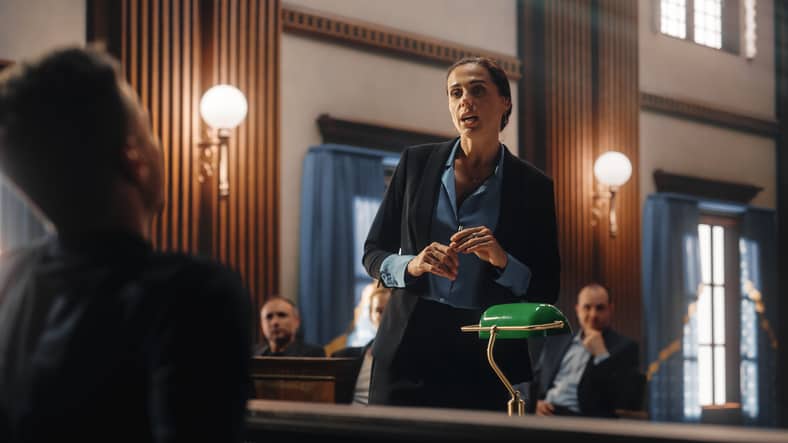The criminal justice system is multi-dimensional and complex. In fact, to someone who isn’t immersed in the field, it can even be a bit confusing. Understanding the differences between state and federal cases, the appellate court system, elected and appointed officials, types of attorneys, crime classifications, non-criminal proceedings, what types of cases district attorneys handle and other criminal justice jargon can certainly be daunting.
While we won’t explain every aspect of the criminal justice system, we will explore the courtroom process at the state level, including:

- Who are the key players in a District Attorney’s office?
- How are cases given to the DA’s office?
- What types of cases do District Attorneys handle?
- What is the courtroom process?
- What is the ultimate goal of the DA’s office?
A Crime Occurs and Charges are Filed
After a crime is committed and law enforcement has determined probable cause, the case is presented to the District Attorney’s office. It is the DA’s responsibility to decide what – if any – charges will be filed against the suspect based on the circumstances of the case, the findings of the law enforcement investigation, and whether it is believed that guilt can be proven beyond a reasonable doubt. If sufficient criminal evidence exists, the DA will decide what charge(s) to file.
Only criminal cases (felony, misdemeanor, and juvenile) are handled by the DA’s office. This means that the DA won’t handle legal matters such as child custody, divorce, or bankruptcy. The DA’s office only prosecutes violations of state laws, not federal crimes. Federal crimes are prosecuted through the federal court system.
A note: although many of the legal steps may look similar to a misdemeanor or felony procedure, a juvenile case is different in that the purpose of the legal proceedings is to result in rehabilitation, rather than retribution.
Inside the District Attorney’s Office
Within the DA’s Office, the District Attorney is an elected or appointed official who leads a team of Assistant District Attorneys (ADAs), also known as prosecutors, representing the county in which a state law is violated. One of the ADAs will be delegated by the DA to represent the state for each case. Along with the ADAs, the District Attorney’s office can also consist of DA Investigators and administrative support staff. Together, the employees working in a DA’s office typically collaborate on many (even hundreds of) active cases at a time. Aside from leading the team of prosecutors, the District Attorney also has multiple roles within the community.
The Courtroom Process
Once the DA’s Office files criminal charges, the prosecution process ensues. At this point, the suspect is now known as the defendant. All further proceedings are handled by the DA’s Office and can only be concluded in one of the following four manners:
1. The state can drop the case.
This can occur for a variety of reasons, including insufficient evidence, Fourth Amendment or procedural violations, a lack of resources to prosecute, or lack of cooperation by victims or witnesses. It is up to the DA’s Office to make this decision.
2. The court can dismiss the case.
This can occur after the trial process has begun and is usually due to factors such as procedural error, reasonable doubt about the defendant’s guilt, or illegally obtained evidence.
3. A plea deal is arranged between the prosecutor and defendant.
This involves the defendant pleading “guilty” or “no contest” prior to trial, and in exchange the DA’s Office will drop or reduce one or more charges. The defendant avoids trial by admitting to the crime and agrees to sentencing by the judge, in hopes of receiving a lighter sentence.
4. A verdict is reached in court.
The period of time leading up to a trial – which can be weeks or even months – is extremely busy for the DA’s Office. Preparation involves collecting, organizing, and studying the evidence, interviewing and preparing witnesses to testify, thoroughly reading reports, developing trial strategy, anticipating potential problems that could arise, filing motions with the court, and practicing the courtroom presentation. OSCR360 can assist the DA’s office in the activities and case organization leading up to trial.
During a process known as “discovery,” the prosecutor must share the evidence that will be used at trial with the defendant. A strong case may result in a plea bargain, but otherwise, the defendant pleads “not guilty.”
During the first phase of a trial, the prosecutor works with the defense attorney to select a jury. The District Attorney’s Office presents their case, including opening statements, calling witnesses, and presenting evidence. The defense attorney cross-examines the prosecution’s witnesses and calls new witnesses, who can then be cross-examined by the prosecutor. During witness examination, the prosecutor may object to certain questions or testimony, allowing the judge to make a ruling on whether the action will be allowed to continue.
Next comes closing arguments, during which the prosecutor and defense attorney have the opportunity to make final statements to the jury. After, the court provides instruction to the jury and the jury deliberates until a unanimous verdict is reached. A not-guilty verdict means the defendant is free to go.
Sentencing will follow a guilty verdict. In the instance of a hung jury, when a verdict cannot be reached, the case may be re-tried.

The Purpose of the District Attorney’s Office
District Attorneys are on the public’s side. They support the constitution, represent the state, and carefully examine both sides of a case to ensure that justice is served. The DA’s Office is not looking to simply convict, but rather seek justice within the bounds of the law.
No matter what types of cases a district attorney handles, a DA must execute integrity and balanced judgement when deciding whether or not to pursue criminal charges. A DA must also protect the innocent and convict the guilty using proof and evidence, all while respecting the legal rights of all people involved, including suspects, defendants, victims and witnesses.
Ultimately, the District Attorney’s Office serves as a group of powerful advocates working together for the best interests of the community.